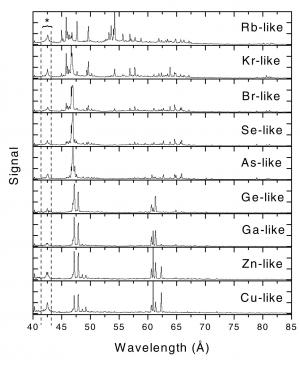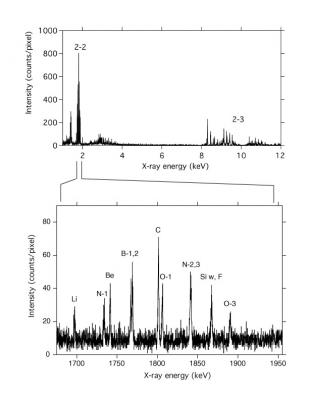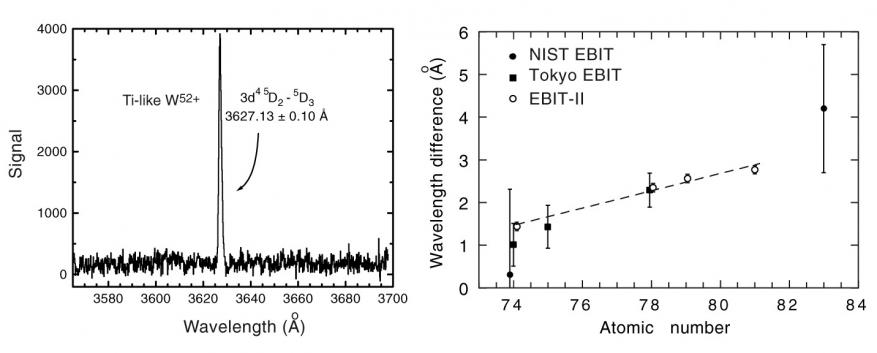Tungsten (W) is element 74, that is, a tungsten atom has 74 protons (and many neutrons) in the core and (as a neutral atom) 74 electrons in the electronic shells. Tungsten ("tung sten" means "heavy stone" in Swedish) is one of the heavy elements (close to gold, element 79) and is mechanically very sturdy. It has a particularly high melting point, which makes it most suitable for use as the filament material of incandescent light bulbs. The same properties make it an attractive material for plasma experiments in which thin wires are heated by strong electrical currents until a high-density plasma is formed (see the Z pinch work at Reno NV) and for magnetic fusion devices in which heat-bearing mechanical structures often are made of tungsten (which after surface erosion may contaminate the plasma). In a hot environment, even tungsten atoms give up one or more electrons (that is, they become ions). If one can determine (by spectroscopic analysis of the emitted light) which ionization stage of an element has been reached, one can measure the temperature of a plasma. Taking advantage of the admixture of tungsten tracer ions, tungsten spectra can serve as a helpful diagnostic in the various temperature zones of a fusion plasma device. The proposed use of tungsten in the ITER machine, which is designed to contain a burning plasma, has added new urgency to understand the properties of this element when embedded in a hot (30 to 40 keV or 300 to 400 Million degrees C) environment that exceeds our sun in temperature. At such temperatures, tungsten ions will lose most of their electrons. W64+, a tungsten ion with only 10 remaining electrons (Ne-like) will play a prominent role.
EBIT Measurements on Tungsten
The Livermore EBIT group has been pursuing studies of tungsten spectra from the visible to the X-ray range for over 20 years. This work established basic atomic properties of tungsten, and includes understanding the atomic structure of various ionization stages, collision properties necessary for charge balance, and rate kinetics that determines the strength of spectral lines. In addition to such fundamental work, the EBIT has directly supported tungsten research applied to:
- X-ray lasers
- the NSTX tokamak at Princeton
- the University of Reno Z pinch
- the SSPX spheromak at Livermore
We have been collaborating with theory groups (especially at Notre Dame and in Puerto Rico). Some of the results of our EBIT measurements are shown below.
Systematic analysis of EUV spectra
At a given electron beam energy, several charge states of the desired element will be present in EBIT, just as in any hot plasma. In an EBIT, however, the electron beam can be varied and thus the charge state distribution controlled. Especially the highest charge state reached is limited by the sequence of ionization potentials. By a systematic progression of electron beam energy values, spectra can be recorded that differ by the contributions of just the highest charge state. The figure shows such a progression of tungsten spectra in the extreme ultraviolet. Each spectrum is labeled by the tungsten ion charge state that is expected to be optimally produced.
Highly accurate spectral measurements test quantum mechanics and QED
Tungsten data have been recorded that aimed at a measurement precision high enough to test QED contributions to atomic structure. Examples are EUV wavelength measurements on Li- through Mg-like and on Cu- and Zn-like ions (including those of tungsten) that reach up to uranium (Z=92) and test QED and many-electron theory (Utter et al. 2003b, 2003c, Träbert et al. 2004, Podpaly et al. 2009, Clementson et al. 2010). For ions with a single electron outside of closed shells adequate calculations were identified. The insufficient accuracy of calculations for ions with two or more electrons in the valence shell that was demonstrated by our data has since instigated improved calculations, for example in our collaboration with the University of Puerto Rico.
Broad band observations with a microcalorimeter
The EBIT calorimeter spectrometer (ECS), a microcalorimeter built at Goddard Space Flight Center, permits the observation of wide-band X-ray spectra (much wider than the working range of a crystal spectrometer) with a much higher resolution than available from a conventional solid state detector. The ECS provides an energy resolution of about 5 eV over the working range range from 0.5 to 15 keV. The upper figure to the right shows a sample spectrum for tungsten, with groups of lines from 2-2 and 2-3 transitions in ions with an open n=3 shell (Ne- through Fe-like spectra).
High resolution X-ray spectra from crystal spectrometers
As an example, a small section of the survey spectrum depicted to the right has also been observed with a flat crystal spectrograph (and at a higher electron beam energy) (lower figure). The detail spectrum shows 2s1/2 - 2p3/2 transitions in Li- through F-like ions of tungsten. The accuracy of these spectra tests the QED contribution to the transition energy at a level of 5 to 10% (Podpaly et al. 2009).
E2 / M3 lines in Ni-like tungsten observed with high resolution
High spectral resolution (in a limited spectral range) can be achieved with a crystal spectrometer. In Ni-like ions, the lowest excited level can decay only by a magnetic octupole (M3) transition. Such a transition has first been seen with thorium (element 90) and uranium (element 92) ions in SuperEBIT. The long lifetime of the 3d94s 3D3 level was first measured in Ni-like xenon (element 54), and also the E2-M3 hyperfine mixing effect on the J=3 level by the nearby J=2 level was observed by a lifetime measurement on specific isotopes. In tokamak plasmas a single line of Ni-like tungsten has been observed that has potential for density diagnostics. Work at EBIT has split this line into the two components from electric quadrupole (E2) and M3 decays, has determined the level splitting, and has quantitatively established the spectral resolution necessary to use these lines for plasma diagnostics (Clementson et al. 2009).
Plasma diagnostics offered by a spectral line in Ti-like ions
A particular transition in Ti-like ions has been suggested for various uses in plasma diagnostics, because the wavelength of this transition is in the same spectral range (near ultraviolet) for many elements, and thus would require only a single experimental set-up. The LLNL EBIT group has devised a spectrometer based on a high-efficiency transmission grating and observed the line of interest in tungsten (see left figure, below) and in several other elements. The comparison of the results obtained at our EBIT-II with results from other EBIT work using conventional spectrometers (right figure, below) is striking. Note that the error bars of our work are hardly larger than the symbols. Only at this accuracy the isoelectronic trend (broken line) was established well enough to distinguish between alternate line assignments in bismuth (Bi, element 81).
Partial bibliography of LLNL EBIT work on tungsten
Measurement of an unusual M1 Transition in the Ground State of Ti-like W52+
S. B. Utter, P. Beiersdorfer, and G. V. Brown
Physical Review A 61, 503-506 (2000).
Electron Beam Ion Trap Spectra of Tungsten in the EUV
S. B. Utter, P. Beiersdorfer, and E. Träbert
Canadian Journal of Physics 80, 1503-1515 (2002).
Wavelength Measurement of the Prominent M1 Transition in the Ground State of Ti-like Pt, Au, and Tl Ions
S. B. Utter, P. Beiersdorfer, and E. Träbert
Physical Review A 67, 012508 (2003)
Wavelengths of the 4s1/2–4p3/2 resonance lines in Cu-like heavy ions
S. B. Utter, P. Beiersdorfer, E. Träbert, and E. J. Clothiaux
Physical Review A 67, 032502 (2003)
Accurate wavelengths of resonance lines in Zn-like heavy ions
S. B. Utter P. Beiersdorfer, and E. Träbert
Canadian Journal of Physics 81, 911 (2003)
Wavelengths of the 4s1/2 - 4p3/2 resonance lines in Cu- and Zn-like heavy ions
E. Träbert, P. Beiersdorfer, H. Chen
Physical Review A 70, 032506 (2004)
Development of M-shell x-ray spectroscopy and spectropolarimetry of Z-pinch tungsten plasmas
A. Shlyaptseva, D. Fedin, S. Hamasha, C. Harris, V. Kantsyrev, P. Neill, N. Ouart, U. I. Safronova, P. Beiersdorfer, K. Boyce, G. V. Brown, R. Kelley, C. A. Kilbourne, and F. S. Porter
Review of Scientific Instruments 75, 3750 (2004)
The study of X-ray M-shell spectra of W ions from the Livermore electron beam ion trap
P. Neill. C. Harris, A. S. Shlyaptseva, S. Hamasha, S. Hansen, P. Beiersdorfer, and U. I. Safronova
Canadian Journal of Physics 82, 931 (2004)
High-resolution spectroscopy of 2s1/2 - 2p3/2 transitions in W65+ through W71+
Y. Podpaly, J. Clementson, P. Beiersdorfer, J. Williamson, G. V. Brown, and M. F. Gu
Physical Review A 80, 052504 (2009)
X-ray spectroscopy of E2 and M3 transitions in Ni-like W
J. Clementson, P. Beiersdorfer, and M. F. Gu
Physical Review A 81, 012505 (2010)
Spectroscopy of M-shell x-ray transitions in Zn-like through Co-like W
J. Clementson, P. Beiersdorfer, G. V. Brown, and M. F. Gu
Physica Scripta 81, 015301 (2010)
Wavelength measurement of n=3 to n=3 transitions in highly charged tungsten ions
J. Clementson, P. Beiersdorfer
Physical Review A 81, 052509 (2010)
Tungsten spectroscopy relevant to the diagnostics of ITER divertor plasmas
J. Clementson, P. Beiersdorfer, E. W. Magee, H. S. McLean, and R. D. Wood
J. Phys. B: At. Mol. Opt. Phys. 43, 144009 (2010)
Tungsten spectroscopy at the Livermore electron beam ion trap facility
J. Clementson, P. Beiersdorfer, G. V. Brown, M. F. Gu, S. Huldt, H. Lundberg, Y. Podpaly, S. Svanberg, E. Träbert
Can. J. Phys. 89, 571 (2011)
Tungsten measurement on Alcator C-Mod and EBIT for future fusion reactors
Y. A. Podpaly, J. E. Rice, P. Beiersdorfer, M. L. Reinke, J. Clementson, and H. S. Barnard Can. J. Phys. 89, 591 (2011)







